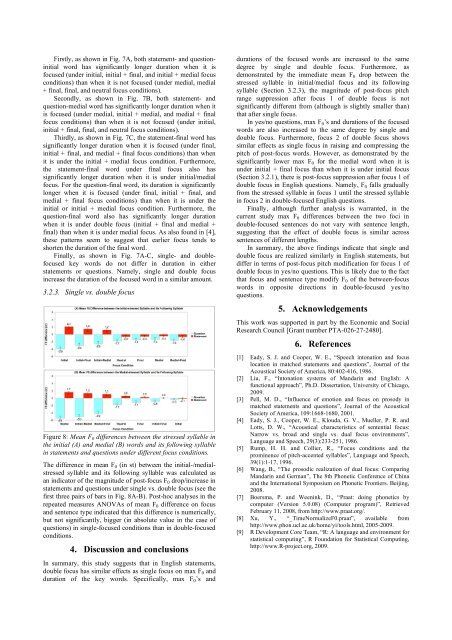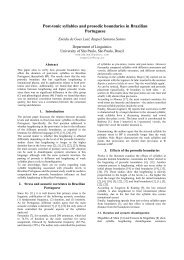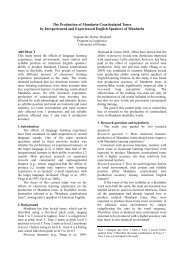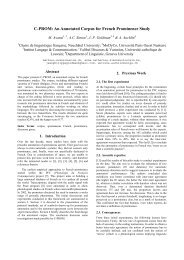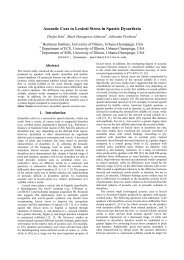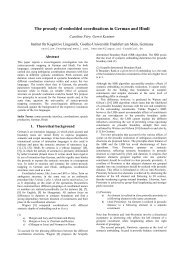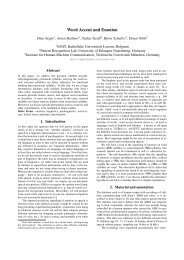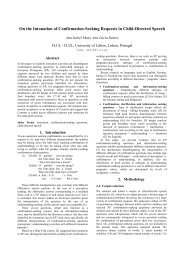Single vs. double focus in English statements and yes/no questions
Single vs. double focus in English statements and yes/no questions
Single vs. double focus in English statements and yes/no questions
Create successful ePaper yourself
Turn your PDF publications into a flip-book with our unique Google optimized e-Paper software.
Firstly, as shown <strong>in</strong> Fig. 7A, both statement- <strong>and</strong> question<strong>in</strong>itial<br />
word has significantly longer duration when it is<br />
<strong>focus</strong>ed (under <strong>in</strong>itial, <strong>in</strong>itial + f<strong>in</strong>al, <strong>and</strong> <strong>in</strong>itial + medial <strong>focus</strong><br />
conditions) than when it is <strong>no</strong>t <strong>focus</strong>ed (under medial, medial<br />
+ f<strong>in</strong>al, f<strong>in</strong>al, <strong>and</strong> neutral <strong>focus</strong> conditions).<br />
Secondly, as shown <strong>in</strong> Fig. 7B, both statement- <strong>and</strong><br />
question-medial word has significantly longer duration when it<br />
is <strong>focus</strong>ed (under medial, <strong>in</strong>itial + medial, <strong>and</strong> medial + f<strong>in</strong>al<br />
<strong>focus</strong> conditions) than when it is <strong>no</strong>t <strong>focus</strong>ed (under <strong>in</strong>itial,<br />
<strong>in</strong>itial + f<strong>in</strong>al, f<strong>in</strong>al, <strong>and</strong> neutral <strong>focus</strong> conditions).<br />
Thirdly, as shown <strong>in</strong> Fig. 7C, the statement-f<strong>in</strong>al word has<br />
significantly longer duration when it is <strong>focus</strong>ed (under f<strong>in</strong>al,<br />
<strong>in</strong>itial + f<strong>in</strong>al, <strong>and</strong> medial + f<strong>in</strong>al <strong>focus</strong> conditions) than when<br />
it is under the <strong>in</strong>itial + medial <strong>focus</strong> condition. Furthermore,<br />
the statement-f<strong>in</strong>al word under f<strong>in</strong>al <strong>focus</strong> also has<br />
significantly longer duration when it is under <strong>in</strong>itial/medial<br />
<strong>focus</strong>. For the question-f<strong>in</strong>al word, its duration is significantly<br />
longer when it is <strong>focus</strong>ed (under f<strong>in</strong>al, <strong>in</strong>itial + f<strong>in</strong>al, <strong>and</strong><br />
medial + f<strong>in</strong>al <strong>focus</strong> conditions) than when it is under the<br />
<strong>in</strong>itial or <strong>in</strong>itial + medial <strong>focus</strong> condition. Furthermore, the<br />
question-f<strong>in</strong>al word also has significantly longer duration<br />
when it is under <strong>double</strong> <strong>focus</strong> (<strong>in</strong>itial + f<strong>in</strong>al <strong>and</strong> medial +<br />
f<strong>in</strong>al) than when it is under medial <strong>focus</strong>. As also found <strong>in</strong> [4],<br />
these patterns seem to suggest that earlier <strong>focus</strong> tends to<br />
shorten the duration of the f<strong>in</strong>al word.<br />
F<strong>in</strong>ally, as shown <strong>in</strong> Fig. 7A-C, s<strong>in</strong>gle- <strong>and</strong> <strong>double</strong><strong>focus</strong>ed<br />
key words do <strong>no</strong>t differ <strong>in</strong> duration <strong>in</strong> either<br />
<strong>statements</strong> or <strong>questions</strong>. Namely, s<strong>in</strong>gle <strong>and</strong> <strong>double</strong> <strong>focus</strong><br />
<strong>in</strong>crease the duration of the <strong>focus</strong>ed word <strong>in</strong> a similar amount.<br />
3.2.3. <strong>S<strong>in</strong>gle</strong> <strong>vs</strong>. <strong>double</strong> <strong>focus</strong><br />
Figure 8: Mean F 0 differences between the stressed syllable <strong>in</strong><br />
the <strong>in</strong>itial (A) <strong>and</strong> medial (B) words <strong>and</strong> its follow<strong>in</strong>g syllable<br />
<strong>in</strong> <strong>statements</strong> <strong>and</strong> <strong>questions</strong> under different <strong>focus</strong> conditions.<br />
The difference <strong>in</strong> mean F 0 (<strong>in</strong> st) between the <strong>in</strong>itial-/medialstressed<br />
syllable <strong>and</strong> its follow<strong>in</strong>g syllable was calculated as<br />
an <strong>in</strong>dicator of the magnitude of post-<strong>focus</strong> F 0 drop/<strong>in</strong>crease <strong>in</strong><br />
<strong>statements</strong> <strong>and</strong> <strong>questions</strong> under s<strong>in</strong>gle <strong>vs</strong>. <strong>double</strong> <strong>focus</strong> (see the<br />
first three pairs of bars <strong>in</strong> Fig. 8A-B). Post-hoc analyses <strong>in</strong> the<br />
repeated measures ANOVAs of mean F 0 difference on <strong>focus</strong><br />
<strong>and</strong> sentence type <strong>in</strong>dicated that this difference is numerically,<br />
but <strong>no</strong>t significantly, bigger (<strong>in</strong> absolute value <strong>in</strong> the case of<br />
<strong>questions</strong>) <strong>in</strong> s<strong>in</strong>gle-<strong>focus</strong>ed conditions than <strong>in</strong> <strong>double</strong>-<strong>focus</strong>ed<br />
conditions.<br />
4. Discussion <strong>and</strong> conclusions<br />
In summary, this study suggests that <strong>in</strong> <strong>English</strong> <strong>statements</strong>,<br />
<strong>double</strong> <strong>focus</strong> has similar effects as s<strong>in</strong>gle <strong>focus</strong> on max F 0 <strong>and</strong><br />
duration of the key words. Specifically, max F 0 ’s <strong>and</strong><br />
durations of the <strong>focus</strong>ed words are <strong>in</strong>creased to the same<br />
degree by s<strong>in</strong>gle <strong>and</strong> <strong>double</strong> <strong>focus</strong>. Furthermore, as<br />
demonstrated by the immediate mean F 0 drop between the<br />
stressed syllable <strong>in</strong> <strong>in</strong>itial/medial <strong>focus</strong> <strong>and</strong> its follow<strong>in</strong>g<br />
syllable (Section 3.2.3), the magnitude of post-<strong>focus</strong> pitch<br />
range suppression after <strong>focus</strong> 1 of <strong>double</strong> <strong>focus</strong> is <strong>no</strong>t<br />
significantly different from (although is slightly smaller than)<br />
that after s<strong>in</strong>gle <strong>focus</strong>.<br />
In <strong>yes</strong>/<strong>no</strong> <strong>questions</strong>, max F 0 ’s <strong>and</strong> durations of the <strong>focus</strong>ed<br />
words are also <strong>in</strong>creased to the same degree by s<strong>in</strong>gle <strong>and</strong><br />
<strong>double</strong> <strong>focus</strong>. Furthermore, <strong>focus</strong> 2 of <strong>double</strong> <strong>focus</strong> shows<br />
similar effects as s<strong>in</strong>gle <strong>focus</strong> <strong>in</strong> rais<strong>in</strong>g <strong>and</strong> compress<strong>in</strong>g the<br />
pitch of post-<strong>focus</strong> words. However, as demonstrated by the<br />
significantly lower max F 0 for the medial word when it is<br />
under <strong>in</strong>itial + f<strong>in</strong>al <strong>focus</strong> than when it is under <strong>in</strong>itial <strong>focus</strong><br />
(Section 3.2.1), there is post-<strong>focus</strong> suppression after <strong>focus</strong> 1 of<br />
<strong>double</strong> <strong>focus</strong> <strong>in</strong> <strong>English</strong> <strong>questions</strong>. Namely, F 0 falls gradually<br />
from the stressed syllable <strong>in</strong> <strong>focus</strong> 1 until the stressed syllable<br />
<strong>in</strong> <strong>focus</strong> 2 <strong>in</strong> <strong>double</strong>-<strong>focus</strong>ed <strong>English</strong> <strong>questions</strong>.<br />
F<strong>in</strong>ally, although further analysis is warranted, <strong>in</strong> the<br />
current study max F 0 differences between the two foci <strong>in</strong><br />
<strong>double</strong>-<strong>focus</strong>ed sentences do <strong>no</strong>t vary with sentence length,<br />
suggest<strong>in</strong>g that the effect of <strong>double</strong> <strong>focus</strong> is similar across<br />
sentences of different lengths.<br />
In summary, the above f<strong>in</strong>d<strong>in</strong>gs <strong>in</strong>dicate that s<strong>in</strong>gle <strong>and</strong><br />
<strong>double</strong> <strong>focus</strong> are realized similarly <strong>in</strong> <strong>English</strong> <strong>statements</strong>, but<br />
differ <strong>in</strong> terms of post-<strong>focus</strong> pitch modification for <strong>focus</strong> 1 of<br />
<strong>double</strong> <strong>focus</strong> <strong>in</strong> <strong>yes</strong>/<strong>no</strong> <strong>questions</strong>. This is likely due to the fact<br />
that <strong>focus</strong> <strong>and</strong> sentence type modify F 0 of the between-<strong>focus</strong><br />
words <strong>in</strong> opposite directions <strong>in</strong> <strong>double</strong>-<strong>focus</strong>ed <strong>yes</strong>/<strong>no</strong><br />
<strong>questions</strong>.<br />
5. Ack<strong>no</strong>wledgements<br />
This work was supported <strong>in</strong> part by the Eco<strong>no</strong>mic <strong>and</strong> Social<br />
Research Council [Grant number PTA-026-27-2480].<br />
6. References<br />
[1] Eady, S. J. <strong>and</strong> Cooper, W. E., “Speech <strong>in</strong>tonation <strong>and</strong> <strong>focus</strong><br />
location <strong>in</strong> matched <strong>statements</strong> <strong>and</strong> <strong>questions</strong>”, Journal of the<br />
Acoustical Society of America, 80:402-416, 1986.<br />
[2] Liu, F., “Intonation systems of M<strong>and</strong>ar<strong>in</strong> <strong>and</strong> <strong>English</strong>: A<br />
functional approach”, Ph.D. Dissertation, University of Chicago,<br />
2009.<br />
[3] Pell, M. D., “Influence of emotion <strong>and</strong> <strong>focus</strong> on prosody <strong>in</strong><br />
matched <strong>statements</strong> <strong>and</strong> <strong>questions</strong>”, Journal of the Acoustical<br />
Society of America, 109:1668-1680, 2001.<br />
[4] Eady, S. J., Cooper, W. E., Klouda, G. V., Mueller, P. R. <strong>and</strong><br />
Lotts, D. W., “Acoustical characteristics of sentential <strong>focus</strong>:<br />
Narrow <strong>vs</strong>. broad <strong>and</strong> s<strong>in</strong>gle <strong>vs</strong>. dual <strong>focus</strong> environments”,<br />
Language <strong>and</strong> Speech, 29(3):233-251, 1986.<br />
[5] Rump, H. H. <strong>and</strong> Collier, R., “Focus conditions <strong>and</strong> the<br />
prom<strong>in</strong>ence of pitch-accented syllables”, Language <strong>and</strong> Speech,<br />
39(1):1-17, 1996.<br />
[6] Wang, B., “The prosodic realization of dual <strong>focus</strong>: Compar<strong>in</strong>g<br />
M<strong>and</strong>ar<strong>in</strong> <strong>and</strong> German”, The 8th Phonetic Conference of Ch<strong>in</strong>a<br />
<strong>and</strong> the International Symposium on Phonetic Frontiers. Beij<strong>in</strong>g,<br />
2008.<br />
[7] Boersma, P. <strong>and</strong> Ween<strong>in</strong>k, D., “Praat: do<strong>in</strong>g phonetics by<br />
computer (Version 5.0.08) (Computer program)”, Retrieved<br />
February 11, 2008, from http://www.praat.org/.<br />
[8] Xu, Y., “_TimeNormalizeF0.praat”, available from<br />
http://www.phon.ucl.ac.uk/home/yi/tools.html, 2005-2009.<br />
[9] R Development Core Team, “R: A language <strong>and</strong> environment for<br />
statistical comput<strong>in</strong>g”, R Foundation for Statistical Comput<strong>in</strong>g,<br />
http://www.R-project.org, 2009.


